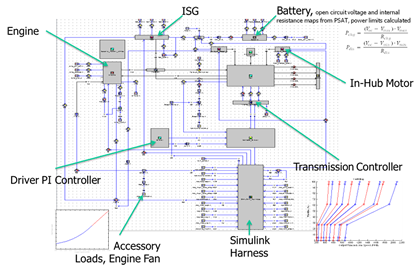Intelligent Power Systems
Annual PlanDevelopment of a High Fidelity Vehicle Energy Assessment Simulation and Implementation in the GT-Drive Framework
Project Summary
Principal Investigators
- Dennis Assanis, Aris Babajimopoulos, Zoran Filipi, Dohoy Jung, Huei Peng, University of Michigan
Students
- Abhishek Bhat, Srinath Gopinath, Kyung Hyun Kwak, Ann Marie Lewis, Vijai Manikandan, University of Michigan
Government
- Denise Rizzo, Mike Pozolo, Carl Johnson, Paul Maguire, Rob Berlin, U.S. Army GVSC
Projected duration Sept. 2009 - mid-2011.

GVSC’S CASSI group was engaged in the assessment of technology options for improving vehicle fuel economy of tactical vehicles under the Fuel Efficiency Demonstrator (FED) Project. More specifically, the M1114 High Mobility Multipurpose Wheeled Vehicle of at least 18,000 lbs gross vehicle weight (GVW) was to be used as a baseline for developing concepts. GT-Drive was selected as the framework for performing vehicle fuel economy evaluations. While this commercially-available software provided several default models for modeling engines, transmissions, drivers, electrical accessories, power management strategies, etc., the prediction fidelity did not satisfy GVSC needs. The ability of GT-Drive to be interfaced with MATLAB-Simulink enabled this project team to port more sophisticated models into the simulation environment. This allowed us to build on the experience developed in the ARC where high-fidelity models of numerous powertrain configurations (conventional and hybrid) have been built in the home-grown, VESIM platform in SIMULINK.
The following higher-fidelity vehicle energy assessment simulation areas were enhanced in the GT-Drive framework:
- Development of engine brake performance and fuel economy maps for advanced engine configurations
- Development of advanced transmission models and associated control strategies
- Development of hybrid electric system components and systems
- Development of advanced power management/control strategies
The above models were developed and subsequently tightly coupled with the GT-Drive environment using SIMULINK. All models were provided to GVSC in an open, editable format.
As a result of the above enhancements, the GT-Drive framework is capable of simulating fuel economy and performance in a realistic manner, taking into account transient behavior and control system characteristics. It also simulates a large number of pre-defined configurations (conventional, parallel hybrid, etc.). The use of forward-looking model architectures provides the framework with a “real-world” causality ideal for control system analysis and design. Because of its accurate dynamic component models, the enhanced GT-Drive framework is directly implementable in both Hardware-In-the Loop laboratory and vehicle settings. This ability enables the framework to be transported from the virtual world of component modeling and simulation to the physical controller design for a practical vehicle.
This modeling and simulation framework has been transferred to GVSC-CASSI and was used in the FED project.

